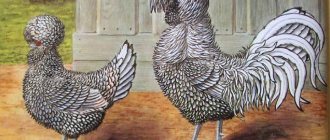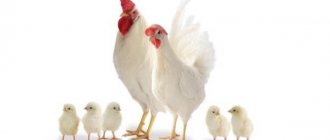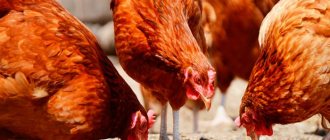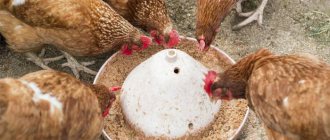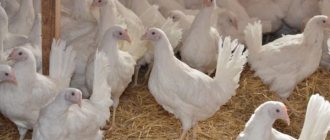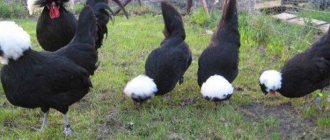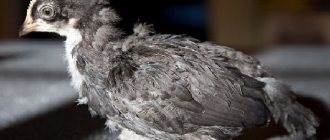The Hisex Brown chicken breed is very common in the Russian Federation. “Hisex” gained its popularity due to its high egg production rates, ease of care and high survival rate.
If we consider Hisex Brown from the point of view of a professional breeder, then calling these chickens a “breed” is not entirely correct, since this is a cross of the Leghorn breed. But people still call Hisex Brown a breed, like most other hybrids.
For the first time, scientists from the Netherlands began breeding this cross. The company responsible for creating the hybrid is Eubrid. The first chickens appeared in 1970 and a few years later they entered the territory of Russia, where they gained good popularity in a short time.
In the publication you will find a detailed description of the Hisex Brown cross, see its photo, and also read reviews from users who were lucky enough to meet this chicken.
Description Hisex Brown
Cross Hisex Brown has the following characteristics:
- Large and massive build.
- The head is medium size.
- The comb is pea-shaped, painted scarlet. The comb can be either erect or hanging.
- The earrings are round, small in size.
- The beak is of medium length, light yellow in color.
- The legs are set quite wide, large, bright yellow.
- The feathers fit very tightly together.
- The plumage color is brown. Sometimes there are white spots at the tips.
- The average weight of an adult laying hen reaches 1.9-2 kg.
- The average weight of roosters is 2-2.5 kg. There are individual individuals that can weigh about 3 kg.
Raising young animals
Cross Hisex Brown (brown) is not a full-fledged breed, so in the second or third generation it easily loses its product characteristics, especially when crossed with other breeds. It is almost impossible to raise these chickens at home. It is advised to buy young animals or hatching eggs from specialized factories.
Incubation
Cross Hisex Brown has practically lost the brooding instinct. Therefore, after purchasing the eggs, you will have to place them under a chicken of a different breed or incubate them artificially. The incubation requirements are standard. Almost 99% of eggs are fertilized, chick hatchability is also 99%, and their survival rate is 95%. This allows even novice farmers to breed the breed.
The chicks are distinguished by their strong constitution and good health. The sex is distinguished already on the second day. The Hisex Brown chicken has darker plumage. In order for chickens to develop safely, it is advised to adhere to the rules of keeping and feeding.
Room for young animals
Before Hisex Brown chickens hatch from their eggs, you need to prepare a chicken coop for them. Basic requirements for the premises:
- no more than 6 individuals are placed per 1 m³ (for day-old chicks, a box with an area of 1 m² is enough for 20-30 individuals);
- temperature in winter - no less than 16 °C, in summer - no more than 24-26 °C (day-old chicks are provided with a temperature of 26-28 °C, and week-old chicks - 22-24 °C);
- young animals are placed in a barn where there are no drafts;
- in the first weeks, provide round-the-clock lighting;
- Bedding for small chicks is made from newspapers folded in several layers. Then it is replaced with wood shavings, sawdust or straw;
- The room is cleaned every 2-3 days.
Feeding the young
In the first few days, Hisex White and Brown chickens are given a boiled egg. Chopped nettle, sorrel, and dandelion are added to it. Some poultry farmers give a little green onion from 4-5 days to prevent infections.
At the end of the first week, the chicks are transferred to mash with water and corn flour, boiled oatmeal and wheat porridge. In the second week, feed is gradually added to small chickens. In the third week, they are completely transferred to feed for young animals or crushed grain mixtures. The diet also includes vegetables, chopped greens, vitamin and mineral complexes. Birds at this age begin to be released outside or moved from the box to a special room in the chicken coop.
When feeding laying hens, it is recommended to follow the following rules:
- once every 15-20 weeks calcium is added to the menu;
- from 20 to 50 weeks, the diet is enriched with proteins and amino acids;
- after 50 weeks they give more minerals;
- after 60 weeks, the caloric content of food is reduced, calcium and other minerals are added.
Chickens are provided with free access to water. Change it 2 times a day. It is recommended to equip closed drinking bowls so that the chicks do not climb into them and get dirty. To prevent infections, add a little potassium permanganate to the water. Large poultry farms practice feeding young animals with antibiotic solutions.
Laying hen productivity
This is an egg hybrid. Browns reach puberty at 4 months of age. Hens begin to lay eggs just during this period (although at home the first clutch can occur at 5 months of age). As for cockerels, he can fertilize a hen from 5 months of age.
Peak productivity of laying hens lasts until 22-23 months of age. On average, one Heisex Brown hen produces from 300 to 320 eggs per year. The eggs are quite large, from 62 to 64 grams. The eggs' shells are brown and very hard, which allows them to be transported over long distances (high commercial value).
It takes a chicken 120-130 grams of feed to produce one egg.
Hisex Brown have a fairly low quality of meat. Even young chickens have tough meat. Considering also the fact that the productivity of poultry is 3 years, earlier slaughter is out of the question.
In industrial enterprises, Brown hybrids, after a decrease in productivity, are sent for processing into animal feed. At home, poultry meat is used to prepare broths.
Chicken diet
Feeding Hisex Brown should be balanced. If the food is of average or poor quality, the hens will not produce the required number of eggs. The simplest option for a proper diet is ready-made feed for laying hens. You should choose mixtures from trusted manufacturers.
You can make compound feed yourself. To do this, mix the following ingredients:
- wheat – 3 parts;
- corn - 3 parts;
- legumes – 2 parts;
- oats – 1 part.
When feeding with self-prepared feed, additional vitamin-mineral complexes and meat-and-bone meal are given. Egg production is increased by the food additive "Premix". In industrial mixtures, vitamins are most often already present. To better grind the grain in the crop, birds are given coarse river sand, fine gravel or pebbles.
The diet also includes fresh and boiled vegetables. In winter they give peelings and boiled potatoes, in summer - zucchini, pumpkins, cucumbers, cabbage and other greens. To replenish fats, the menu includes sunflower meal or cake and flaxseeds. Plant proteins are contained in soybean meal.
In the summer, chickens are allowed to roam freely in the yard. During this period, you can reduce the amount of prepared feed by 10-20%. Hisex Brown laying hens eat green grass well and are able to look for small midges, worms, snails and slugs, replenishing their diet with proteins. Birds are also given specially collected and chopped fresh meadow grass, vegetable tops, and nettles. Hay is prepared for the winter.
Advantages and disadvantages of a hybrid
The advantages of this cross include:
- High egg production rates, which do not depend on the season.
- Chickens have high survival rates, up to 95%.
- Hisex Browns have good immunity, which protects the bird not only from diseases, but also from attacks by parasites.
- This is a fairly easy-to-maintain cross.
- Tolerates low temperatures relatively well and painlessly.
- A completely independent bird that can easily find food in the backyard, which makes keeping chickens more economical.
- In favorable conditions, hens can lay their first clutch as early as 4 months of age.
Recently, Hisex Brown has begun to be bred more and more at home (previously, industrial cultivation predominated). This is due to the fact that more productive hybrids have appeared on the market, which show greater profitability under industrial cultivation conditions.
Does cross have any disadvantages? Yes, just like any other breed or hybrid. The main disadvantages of Hisex Brown include:
- Very weak maternal instinct. Highsex chickens do not hatch eggs, and if they are going to do this, they very rarely make it to the end. For this reason, you have to either purchase chickens on the market or increase the family yourself using incubators.
- In order for chickens to show peak egg production, they must be fed with high-quality feed.
- Highsex meat is of very low quality.
- If you keep crosses in a confined space, they can become excessively noisy and become quite aggressive (this is especially true for the white variety of Highsex).
- This hybrid does not always immediately adapt to a new place of life and owner.
Diseases of the breed
Like any other productive animals, highsex are characterized by characteristic diseases. They often develop instantly among the entire livestock and are characterized not only by an acute course, but also by serious consequences. Therefore, at the first signs of the development of any pathology, the farmer should definitely contact a veterinarian.
Traditionally, the breed is susceptible to the development of the following ailments:
- Marek's disease - most often found in chickens and young animals up to 5 months. The pathology causes indigestion, weight loss, and general depression of the body, which in advanced cases is complemented by paralysis of the limbs. It is caused by various strains of herpeviruses. The disease has no established treatment therapy, since it is most often combated by periodic vaccination of birds. But, when an acute outbreak is detected, chickens are given complex antibiotics. The most popular among them is the drug Acyclovir. The dosage and duration of treatment with Acyclovir is determined solely on the basis of the general condition of the bird and only by an experienced veterinarian;
- Newcastle disease is a complex viral disease caused by paramyxoviruses. The disease causes accumulation of blood in organs and tissues, as well as hemorrhages. Treatment of affected birds is dangerous and often impractical for the farm, therefore infected individuals are killed and disposed of along with their products;
- Gumboro infection is a dangerous viral nephrosis caused by pathogenic microorganisms from the genus Birnaviridae
. The disease occurs quite often in chickens aged 1-4 weeks and is manifested by digestive disorders, which are subsequently accompanied by neurological pathologies. The infection has no effective treatment, so affected young animals are killed and disposed of.
Did you know? Newcastle disease was first identified and described in 1926 on the island of Java (Indonesia), by infectious disease specialist Kraneveld.
In order to avoid poultry infections, every farmer must:
- carefully select young animals when rejuvenating the herd;
- carry out quarantine of new members of the herd;
- provide chickens with optimal sanitary conditions in their housing areas;
- feed the wards exclusively with high-quality and proven feed;
- include all kinds of vitamin supplements and nutrition in the diet;
- Be sure to periodically vaccinate chickens.
Highsex chickens are a fairly productive and widespread breed all over the world. These birds can turn any poultry farm into a profitable and productive enterprise in just a few months. But in order for laying hens to produce stable products, it is necessary to create favorable conditions for them, including optimal sanitary conditions in the places where they are kept.
Poultry keeping
Caring for these crosses is quite simple. This is a completely unpretentious hybrid that even a beginner can grow.
The chicken coop should be light, with good aeration. Chickens do not tolerate very severe frosts, so it is advisable to insulate it. If the temperature in the chicken coop drops to -18 degrees Celsius, then you can expect a significant decrease in egg production.
As for keeping conditions, this is a universal bird. It can be kept in a spacious chicken coop, in the yard, or even in a cramped cage. But it is still better for the bird to grow up in fairly comfortable conditions (no more than 4 individuals per 1 m2).
Nests for Highsex are built at a height of 40 cm from the ground. The area of one nest must be at least 25 cm2.
The backyard does not have to be surrounded by a high fence. This bird flies very poorly and the likelihood that it will fly over even a 1.5 meter fence is very low.
The bedding in the chicken coop is standard. Slaked lime is poured onto the floor. It will destroy pathogenic microorganisms and also draw out excess moisture. A layer of straw and peat, 15 cm thick, is applied to the lime. Once every 6-7 months, a general cleaning is carried out in the chicken coop. Completely replace the top layer and add slaked lime.
Feeding laying hens
It is advisable to place feeders and drinkers along the wall so that the chickens do not knock them over. The water needs to be changed daily to clean and warm. In summer it changes twice a day, and in winter once.
To achieve maximum productivity from this cross, you need to feed it well. Food should be varied, nutritious and valuable. The basis of the Hisex Brown diet is:
- Cereals (wheat, barley, corn, etc.).
- Compound feed.
- Vegetables. Zucchini, potatoes, beets, carrots, pumpkin, etc. are grated.
- Grass tops.
- Chopped legumes (peas, beans).
- Bone or fish meal.
- Powdered eggshells.
- Limestone.
- Salt.
Arrangement of a walking area
According to the breed description, Hisex Brown is a curious and active bird. She definitely needs to be walked. To do this, set up an area surrounded by a high fence.
The bird must have access to grass. It is not recommended to choose dusty areas: chicken lice and other parasitic insects often hide in the dust. Chickens are released daily in warm weather. In winter, sunny days are chosen for walking.
Chickens must eat grass.
Immunity
Cross Hisex has a fairly strong immune system. However, adult individuals are highly susceptible to flea and helminth infestation. Also, Hisex Brown may suffer from:
- Brucellosis.
- Pullorosa.
- Salmonellosis.
- Staphylococcus.
The first signs that a bird is sick are refusal of food and water, and the inability to move independently. If a bird with these symptoms is found in the chicken coop, it must be immediately isolated from the family. The chicken is treated with antibiotics and other medications are used.
After treatment procedures, it is important to wash your hands well with soap.
Diseases and their treatment
Experienced farmers manage to reduce the mortality rate of hays to almost a minimum, which is achieved through timely vaccination and deworming.
Highsex chickens and roosters rarely get sick, but when kept together with ducks, geese and birds of other breeds, they can become infected with lice or helminths, become victims of avian diseases (pullorosis, brucellosis, staphylococcus, salmonellosis) or be poisoned by poor-quality food.
Most diseases are treated by introducing antibiotics into the daily diet.
Signs of the disease:
- lack of appetite;
- joint weakness;
- exhaustion;
- excessive thirst or lack of desire to drink;
- spasms of the respiratory tract;
- sore throat.
Advice! Isolate sick birds from healthy birds. After contact with them, wash your hands and face with soap and rinse your mouth with alcohol. Keep cats and dogs away from bird drinkers and feeders.
Chick care
From the very first days, the chickens are kept warm. The air temperature should be within 30 degrees Celsius. It is also important that the chicks have 24 hours of daylight in the first 2 days.
Particular attention is paid to the cleanliness of the box in which the chickens are located. The bedding, which is made from straw or other similar material, must be changed daily. A little antibiotic can be added to the drinking bowls to prevent infection.
From two weeks of age, chickens can be let out for a walk outside for the whole day.
We also recommend reading: Description of the Brown Nick chicken breed
One of the features of this cross is that from the first days you can distinguish a hen from a rooster. A day after birth, chicks (females) begin to molt and become covered with brown fluff. The cockerels remain yellow. This is the ideal time to separate the chicks into different crates and raise them to avoid mixing them up later.
Tips from the professionals
Professional poultry farmers know some of the subtleties in breeding Hisex Brown laying hens. They make it easier to care for hybrids and achieve good results.
Successful masonry
Some laying hens, as already noted, have no or dulled instinct to lay eggs in the nest. How to make a chicken rush where it's supposed to and how it's supposed to? With a simple trick. Place a table tennis ball or any round ball at the bottom of the nest. If this does not work, watch the capricious hen for some time, and at the moment when she is about to lay an egg on the floor, transfer her to the nest. Two or three times will be enough for the bird to get used to laying eggs where needed.
Golf balls in the chickens' nest
Quality feed
A complete diet - without it, the birds will not have a full clutch. In order to balance feeding as much as possible, it is best to invest in high-quality store-bought feed. But in addition to it, it is necessary to provide green food or not limit access to paddocks. If this happens in winter, root vegetables, fruits and vegetables are introduced into the diet, and additional mineralization is carried out.
Chickens need to be fed correctly and in a balanced manner.
How to distinguish male chicks from females
Distinction by gender in the language of specialists is called sexing. Hisex Brown can be sexualized as early as one day of age. This happens based on the growth rate of feathers on the wing. Hens fledge faster, cockerels - slower. In cockerels, the tips of the feathers are lighter, almost golden. Chickens are more brown.
Video - How to distinguish a female from a male chicken
Cellular content
Many people are interested in whether cage keeping is possible for Hisex Brown crosses. Experts do not recommend it, but most large farms keep birds in cages. It is worth considering that poultry farms generally do not provide walking areas for birds or floor housing. Breeders achieve productivity by introducing a huge amount of additives into the diet, which often do not have the best effect on the quality of eggs, although they provide their quantity.
Cage keeping of chickens
If you are the owner of a small poultry farm or keep them in your backyard, it is more advisable to use a barn or utility room, since it is difficult to let chickens out of numerous cages for walking, as well as to bring them back. One rooster to maintain discipline and free outdoor housing with daily walking is the best option for breeding Hisex Brown.
Together or separately
Different breeds of chickens are kept differently. Some people are advised to separate by gender and keep hens and roosters separately, while others do not. In the case of Hisex Brown hybrids, they usually have males kept separately until they are a week old. They are then evenly distributed throughout the flock of future laying hens. The process occurs gradually, over three weeks, and then the birds are kept together. It has been proven that if males are added to females suddenly and at puberty, egg laying in laying hens can be significantly delayed due to stress.
Keeping chickens
For 100 hens, 10-12 roosters are enough. Males change every 18 months. The fact is that aging males surround the feeders and do not allow the chickens to eat. As soon as this behavior is noticed, males must be isolated and young animals gradually introduced into the herd.
Features of feeding laying hens
For greater productivity, the diet of a laying hen must be adjusted depending on the physiological period in which it is located.
Pre-laying period - starting from the fourth month of life - accumulation of calcium.
1st laying period – after 20 weeks of age – increase in amino acids and protein.
2nd laying period – after 50 weeks – increase in the amount of minerals.
3rd laying period - after 60 weeks - decrease in calories, increase in calcium.
Feed consumption rate for laying hens of different ages
Feeding laying hens
With high egg production, calcium deficiency greatly affects the condition of the laying hens themselves and the quality of the eggs.
Features of drinking
On large poultry farms, water for chickens is chlorinated with special injections of doses of chlorine, and then its balance is controlled so that it does not exceed the norm. It is difficult to carry out such procedures in a home farm, so you can feed chickens with regular tap water. But there are some peculiarities in the drinking process itself.
Firstly, drinkers need to be washed constantly. If possible, disinfect daily with chlorine and thoroughly wash.
Secondly, water for chickens needs to be heated in winter and cooled in summer.
Thirdly, you need to pour water into the drinkers no more than 1.5 cm. That is, the drinkers for Brown chickens should be shallow, since the birds have a medium beak, and it is at this depth that it is convenient for them to drink so that water does not get into the nasal passages .
With a lack of water, the egg lingers in the laying hen’s oviduct, becoming overgrown with extra layers of shell
Feeding the chickens
Chickens of these crosses are fed in the same way as young animals of any other breed. In the first days, babies are given grated boiled egg or cottage cheese mixed with finely chopped herbs. In addition to water, you can pour milk into the drinking bowls. But it is very important to ensure that the milk does not turn sour. Otherwise, this can even lead to the death of chickens.
From the 3rd day of life of young animals, you can add crushed grain and boiled vegetables to the diet.
Up to 14 days of age, young animals are fed 6 times a day. After 2 weeks, they are transferred to 4 feedings a day, which lasts until they are one month old. When the chickens are 1 month old, they are transferred to a three-course diet. When the young are 2 months old, they can be fed as a full-fledged adult.
Reviews
Vladimir Ivanovich, Kyiv, 48 years old.
We raise three breeds of chickens in our backyard: Highsex Browns, Brahma and Leghorns. Of all three breeds, the Highsex are the calmest. In general, they all rush the same way; it cannot be said that any breed is more productive. But in terms of character, I like the Highsex ones the most. They are so calm, zero aggression.
Elena Igorevna, Ekaterinburg, 39 years old.
I would also like to leave my review about the Dutch cross Hisex Brown. My husband and I live in the village, and you yourself understand that it’s a sin not to keep a chicken when there are all the conditions for this. In general, when we were buying young animals at the market, it was Hisex Brown that was recommended to us. I don’t eat chicken, my husband is not a meat eater either, so we took the bird purely for the eggs. What can I tell you about this chicken? Well, after the young ones were brought in, they soon began laying eggs. Now 1 hen produces on average 280-300 eggs per year. Highsex themselves are brown in color, and there may be white spots on the body, usually at the end of the feathers. The character is flexible, not aggressive at all. In terms of maintenance, it is also unpretentious, at least our conditions are normal, and the bird feels good. It withstands our harsh winter very well. The maternal instinct is completely absent. How many times have they been raising this cross, I have never sat on eggs. This is a minus, since hybrids can only be bred by incubation or buying new young animals on the market. But again, they can slip in rejected ones, and then you’ll only suffer.
Story
The Hisex breed first appeared in Holland in 1970 as a result of crossing two well-known species - the Italian egg " Leghorn " and the American beef breed " New Hampshire ", which is also a cross. The resulting hybrid made it possible to significantly increase the egg production rate, making these layers very popular among egg farm keepers.
The selection process took only two years, but this time was enough to create one of the most popular types of egg-laying chickens today. In the countries of the former CIS, the history of the popularity of “Hisex” began in Ukraine, where a batch of poultry was purchased by one of the poultry farms as an experimental one. Subsequently, thanks to their impressive egg productivity, these laying hens became widespread, becoming permanent residents of egg farms even in harsh Siberia.

